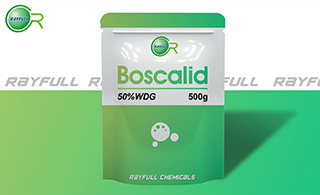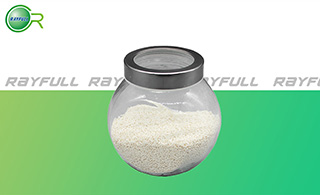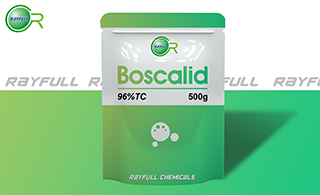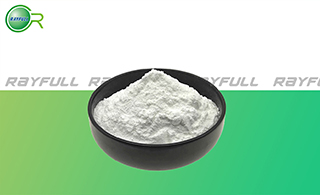Boscalid
    啶酰菌胺 啶酰菌胺
Introduction: Boscalid is a fungicide developed by BASF and launched in 2003 for use on food crops. It works as a succinate dehydrogenase inhibitor to kill fungal target organisms. It is practically nontoxic to terrestrial animals and is moderately toxic to aquatic animals on an acute exposure basis. In subchronic and chronic feeding studies in rats, mice and dogs, boscalid generally caused decreased body weights and body weight gains (primarily in mice) and effects on the liver (increase in weights, changes in enzyme levels and histopathological changes) as well as on the thyroid (increase in weights and histopathological changes). In a developmental toxicity study in rats, no developmental toxicity was observed in the fetuses at the highest dose tested. Boscalid is classified as, suggestive evidence of carcinogenicity, but not sufficient to assess human carcinogenic potential, according to the EPA.
Common name: Boscalid
Another name: Nicobifen; Endura; 2-Chloro-N-(4'-chloro-[1,1'-biphenyl]-2-yl) nicotinamide; Anilide; BAS 510 F; etc.
Chemical name: 2-chloro-N-(4'-chlorobiphenyl-2-yl)nicotinamide
Empirical formula: C18H12Cl2N2O
Structural formula:

Mol. Weight: 343.21 g/mol
CAS No.: 188425-85-6
Specifications
Leading Boscalid supplier
Boscalid 96% TC
Boscalid 50% WDG
Packing:
BULK PACKING
Powder: 25kg/Bag, 25kg/Drum, 50kg/Drum etc.
Liquid: 200L/Drum, 20L/Drum, 10L/Drum etc.
SMALL PACKING
Powder: 1kg/Alu bag, 500g/Alu bag, 200g/Alu bag, 100g/Alu bag, 50g/Alu bag, 15g/Alu bag etc.
Liquid: 5L/Drum, 1L/Bottle, 500ml/Bottle, 250ml/Bottle, 100ml/Bottle, 50ml/Bottle etc.
Customerized packing label
Boscalid FAO standard
Professional registration
HAZARDS IDENTIFICATION
Hazard statement(s)
H411 (100%): Toxic to aquatic life with long lasting effects.
Precautionary statement(s)
P273: Avoid release to the environment.
P391: Collect spillage.
P501: Dispose of contents/container to an approved waste disposal plant.
Supplemental Hazard Statements: none.
MAMMALIAN TOXICOLOGY
Acute toxicity: 1) Acute oral LD50 for rats is >5000 mg/kg. 2) Acute dermal LD50 for rats is >2000 mg/kg. 3) Acute inhalation toxicity LC50 (4 h) for rats is >6.7 mg/L. 4) Skin irritation: Non-irritating to skin (rabbits). 5) Eye irritation: Non-irritating to eyes (rabbits). 6) Skin sensitization for guinea pig: Not a skin sensitizer.
NOEL: (2 y) for rats is 4.4 mg/kg/day; (18 m) for mice is 13 mg/kg/day; (1 y) for dogs is 22 mg/kg/day. Other Not genotoxic.
ADI (JMPR) 0-0.04 mg/kg b.w. [2006]
Classification:
WHO Classification: U (Unlikely to present an acute hazard)
EC Risk Classification: Carcinogen category 3: R40
US EPA Classification (formulation): Not available
ECOTOXICOLOGY
Effect on birds: Acute oral LD50 for Bobwhite quail is >2000 mg/kg. Effect on fish: Acute LC50 (96 h) for Rainbow trout is 2.7 mg/l. Effects on aquatic invertebrates: Acute EC50 (48 h) for Daphnia magna is 5.33 mg/l. Effects on algae: Acute 72 hour EC50 for Pseudokirchneriella subcapitata is 3.75 mg/l. Effects on bees: contact acute 48 hour LD50 is >200 μg/bee, oral acute 48 hour LD50 is 100 μg/bee. Effects on earthworms: Acute 14 day LC50 is >500 mg/kg.
ENVIRONMENTAL FATE
Animals Hydroxylation of the biphenyl ring, subsequent glucuronidation and sulfatation reactions. The systemically available portion of a.i. is rapidly and extensively metabolised, with rapid excretion, mainly via faeces. Plants Hydroxylation in the biphenyl and pyridine rings, and cleavage reactions in both rings, were observed. However, unchanged parent formed the major part of the residue. Soil/Environment Moderate degradation behaviour in soil; soil DT50 108 d to >1 y (lab., aerobic conditions, 20 °C); field DT50 28 d to ca. 200 d. Good degradation in natural water/sediment systems.
Usage: Boscalid was introduced by BASF. It is a fungicide active against a broad range of fungal pathogens in a wide range of crops including vegetables and other crops.
Application: Biochemistry Inhibits succinate ubiquinone reductase, (also known as complex II), in the mitochondrial electron transport chain. Mode of action Foliar fungicide. Uses For control of powdery mildew, Alternaria spp., Botrytis spp., Sclerotinia spp. and Monilia spp. on a range of fruit and vegetables.
| 






